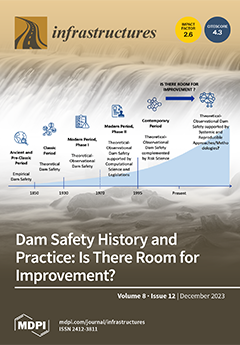In recent years, Interferometric Synthetic Aperture Radar (InSAR) technology has been able to determine the semi-static behavior of bridges. However, most of the research about the use of InSAR in the monitoring of bridges has been applied only in deterministic assessments of their
[...] Read more.
In recent years, Interferometric Synthetic Aperture Radar (InSAR) technology has been able to determine the semi-static behavior of bridges. However, most of the research about the use of InSAR in the monitoring of bridges has been applied only in deterministic assessments of their performance. Therefore, in the current manuscript, the Usumacinta Bridge, located in Mexico, was evaluated based on a probabilistic methodology to define structural reliability using images from Sentinel-1. In addition, a controlled experiment was developed using a corner reflector (CR) to evaluate the capabilities of InSAR for determining vertical displacements. In the trial, the CR was designed, oriented, and implemented, finding discrepancies concerning leveling of less than 2 mm. On the other hand, the case of the alternative probabilistic approach integrates the reliability of structures theory and probability density functions (PDFs) of displacements obtained via InSAR technology. In summary, the proposed study focused on the analysis of two years of vertical displacements and monthly velocities; then, implementing the alternative probabilistic approach, the reliability index (
β) and probability of risk (
PR) of the bridge were extracted, respectively. Based on the results of the experimental part of the paper, the displacements indicated maximum and minimum values of reliability index of 8.1 and 3.4, respectively. Within this context, the mean and standard deviation obtained were 5.9 and 1.4, respectively. On the other hand, the monthly velocities showed a maximum probability of risk of 2.61%, minimum value of 1.5 × 10
−5%, mean of 0.4%, and standard deviation of 0.8%. Hence, the above-documented results indicate that the Usumacinta Bridge did not suffer any damage during its overloading condition period.
Full article





